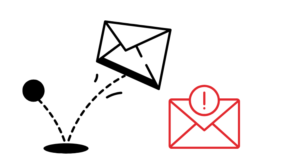Email marketing is essentially a bridge between businesses and their audience, allowing direct communication and personalized engagement. But let’s be honest—sometimes our beautifully-crafted emails don’t always reach their intended destinations. Annoying, right? These non-deliveries are called bounces, and they can turn even the most promising campaign into a headache.
To truly master email marketing, you’ve got to understand the reasons behind these bounces and how to address them. Think of it as troubleshooting for emails, preventing wasted efforts and protecting your reputation as a sender. Sounds important? That’s because it is.
Why Do Bounces Matter?
Simply put, bounces hurt your email marketing ROI. If your emails get bounced back instead of getting into inboxes, it means that part of your investment—whether it’s time, creativity, or money—has gone down the drain. Even worse, repeatedly failing to deliver emails can harm your sender reputation with Internet Service Providers (ISPs), making it more likely that your email campaigns get flagged as spam in the future. Nobody wants that!
Knowing how to navigate this challenge allows you to protect your campaigns, improve engagement, and keep your audience happy. But before we can fix anything, it’s essential to break the problem down into its basic types: hard bounces and soft bounces.
Getting Familiar with the Concept of Returns
To imagine what’s happening behind the scenes, think about sending an actual letter through the post. A hard bounce is like getting your letter back stamped “address no longer exists,” while a soft bounce is like seeing a note that says, “Mailbox is full—try again later.” Both are frustrating, but the solutions differ dramatically. That’s why understanding the difference is critical!
When you’re trying to reach inboxes, every bounce is a signal. The challenge is interpreting that signal correctly so you can make your future emails more effective. Each bounce tells you something valuable, and the key to managing your campaign’s success is listening to these signals carefully.
The Big Picture: Keep Your Eye on Deliverability

Deliverability—how often your emails make it to inboxes—is a core metric for email marketing efficacy. A high bounce rate is one of the first indicators that deliverability might need some attention. By understanding and addressing bounces, you’re not just improving the health of your email database, you’re also working to optimize how your messages are received and perceived.
Remember, email marketing is part art, part science. Crafting appealing content matters, but ensuring it actually gets delivered is equally crucial. While the creative side can be fun, tackling technical hurdles like bounces is key to sharpening your strategy. It’s not just about having a solid email; it’s about making sure that email reaches its destination.
What is a Hard Bounce? Identifying Permanent Delivery Failures
So, let’s talk about hard bounces. Sounds technical, right? Don’t worry, it’s simpler than you think! When we use the term “hard bounce,” we’re diving into a key aspect of email marketing. Think of it as an “unwanted stop sign” for your emails. A hard bounce happens when an email you send permanently fails to reach the recipient’s inbox. Yes, permanently. No retries, no second chances – it’s game over for that email.
What qualifies as a hard bounce?
To really wrap your head around this, picture sending a postcard to someone only to learn the address doesn’t exist. Hard bounces are just like that! They occur for permanent reasons, such as:
- Nonexistent or misspelled email addresses – Sometimes people make typing mistakes when signing up, or the address might simply not exist anymore.
- The domain isn’t active – If the domain attached to the recipient’s email (e.g., @oldcompany.com) has been deactivated or no longer exists, you’re essentially knocking on a door that’s been torn down.
- Email server rejections – In some cases, the recipient’s server may outright refuse emails for specific reasons, like stringent filtering rules.
Why are hard bounces such a big deal?
Great question! Hard bounces can spell trouble if they aren’t managed properly. Here’s why they matter:
- Reputation Risks: If you keep sending emails to invalid addresses, email service providers (ESPs) could flag you as a spammer. Yikes! This could hurt your sender reputation, making it harder for you to land in other customers’ inboxes.
- Wasted Effort: Sending to invalid addresses is like throwing your campaign efforts into the void. It distracts you from connecting with real, engaged audiences.
- Metrics Chaos: Hard bounces mess with your email performance reports. They skew your data, making it harder to interpret what’s working and what’s not.
How can you spot a hard bounce?
Thankfully, most email marketing platforms (like Mailchimp, Campaign Monitor, or (ActiveCampaign) automatically help by monitoring delivery statuses. When you see error reports that indicate an email is “undeliverable” due to reasons like invalid addresses or domain issues, that’s your hard bounce waving at you. These platforms usually label hard bounces clearly so you can act quickly.
What to do about hard bounces?
The solution begins with attention and action. Here are a few quick tips:
- Clean Your List Regularly: Regularly review your email lists and remove invalid addresses. Many providers can automate this for you, saving time and trouble.
- Use Double Opt-Ins: Asking subscribers to confirm their email address is a genius move to fend off typo-prone signups.
- Analyze Patterns: Noticing a sudden spike in hard bounces? This might signal issues with how emails are collected or recent list acquisition sources. Always assess the root cause.
In short, understanding hard bounces is all about recognizing when a door is permanently shut and knowing when to redirect your focus elsewhere. Managing these delivery failures not only boosts your campaign’s returns but also keeps your reputation untarnished. And hey, a cleaner list means you’re reaching people who truly want to hear from you – isn’t that a win-win?
Decoding a Soft Bounce: Temporary Delivery Hiccups
Picture this: you’re throwing an amazing email party, and while some guests (emails) waltz right through the door of your recipient’s inbox, others pause at the threshold. They don’t get outright rejected, but they’re not quite inside, either. These hesitant guests? They’re the “soft bounces” of email marketing.
Let’s dive into what a soft bounce really means and how you can handle these temporary hiccups effectively. Think of this as your guide to becoming an inbox bouncer extraordinaire!
So, What Exactly is a Soft Bounce?
A soft bounce occurs when your email reaches the recipient’s mail server but is turned away for a reason that’s typically *temporary*. Unlike a hard bounce, which is like a stern “never ever” rejection, a soft bounce is more like a polite, “not right now, try again later.” This is why soft bounces are often less alarming — but still worth tracking closely.
Here’s the kicker: email servers usually try to deliver soft-bounced emails again automatically, so there’s still a chance your message will eventually arrive.
What Causes a Soft Bounce? Here’s the Scoop:
- Mailbox Is Full: Everyone’s been there — an overflowing inbox where no new messages can squeeze in.
- Server Issues: Sometimes, the recipient’s email server is having a moment. Maybe it’s down for maintenance or overwhelmed with traffic.
- File Size Woes: Your email might be a bit too hefty (think large attachments or image-heavy templates) for the recipient to accept in its current state.
- Spam Filters: Occasionally, your email might be flagged as suspicious and temporarily held back.
These are just a few causes, but overall, soft bounces are like speed bumps on your email’s journey — they delay, but don’t outright block the outcome. Patience and tweaks can often overcome these issues.
How to Tackle Soft Bounces Like a Pro
Soft bounces aren’t the end of the world — far from it! They’re more like little nudges encouraging you to keep your email game strong. Follow these tips to minimize their occurrence and keep your campaigns cruising:
- Optimize Your File Sizes: Avoid adding excessive attachments or images that could inflate the size of your email. Compress content where possible to make your email lightweight and inviting for inboxes everywhere.
- Maintain a Clean List: Regularly audit your email distribution list. Identify habitual soft bounces and consider re-confirming their subscriptions.
- Monitor & Measure: Keep an eagle eye on delivery reports. If you spot trends in soft bounces for specific recipients or domains, dive into why it might be happening.
- Send at the Right Time: Avoid sending emails when recipients are less likely to open them. If servers get flooded with emails during high-traffic periods, delays are more likely.
- Be Authentic (and Avoid Spam Triggers): Craft emails that are engaging, relevant, and compliant with spam guidelines. If your emails seem suspicious or overly pushy, they might trip temporary filters.
Why Soft Bounces Aren’t All Bad News
Soft bounces can be annoying, sure, but they also provide valuable feedback. Think of them as a heads-up that something in your email strategy might need tweaking. Addressing soft bounces can actually help refine your email campaigns, making them leaner and more effective over time.
Spotting the Clues: How to Differentiate Hard and Soft Bounces

Have you ever wondered why some of your emails don’t make it to your recipients’ inboxes? It can feel like your carefully crafted messages are getting lost in cyberspace. Don’t worry – you’re not alone, and the good news is that understanding email bounces can help solve this mystery.
When an email bounces, it means it couldn’t be delivered to the recipient’s inbox. But not all bounces are created equal. They fall into two categories: hard bounces and soft bounces. These types have some tell-tale signs that will help you easily tell them apart. Here’s how you can spot the difference:
1. Look for the Permanence Factor
The most crucial distinction between the two lies in their permanence:
- Hard Bounces: These are permanent delivery failures. Think of it like trying to send a postcard to a nonexistent or outdated address – no matter how many times you try, it won’t reach its destination. You’ll usually need to remove these addresses from your list right away to avoid repeated failures.
- Soft Bounces: These, on the other hand, are temporary issues. Picture a mailbox that’s full or somebody’s door with a “Do Not Disturb” sign. With soft bounces, there’s still a chance your email could get through later if the situation changes – say, if the mailbox space clears up.
2. Pay Attention to the Error Message
When an email bounces, your email service provider typically sends back an error message explaining why the delivery failed. Reading these messages can provide invaluable clues:
- If the message cites reasons like “email address doesn’t exist” or “domain unavailable,” then it’s a hard bounce. This indicates a more serious, unfixable error.
- If the error mentions something like “mailbox full” or “server temporarily unavailable,” chances are, you’re dealing with a soft bounce.
3. Frequency of Occurrence
Here’s another ace up your sleeve: frequency. If you consistently see the same email bouncing over multiple campaigns, it’s likely a hard bounce. In contrast, soft bounces are often sporadic and might resolve themselves after a few attempts.
4. Use Data to Your Advantage
Leveraging data from your email service provider’s analytics tool is key. Most platforms will flag hard bounces so you can quickly see which addresses need to be removed. They also track soft bounces, helping you decide whether those recipients’ inbox issues might resolve over time or if they should also be re-evaluated and cleaned from your list.
Why It Matters
Knowing how to differentiate between hard and soft bounces is like reading a map for your email campaigns. Ignoring hard bounces and re-sending to invalid addresses can harm your email sender reputation, while addressing soft bounces can increase the chances of your messages eventually reaching your audience. It’s all about being proactive and informed!
Common Causes Behind Hard and Soft Bounces
Email bounces can be frustrating—you’re all set with a dazzling email campaign, only to watch some emails bounce back, unread and rejected. Understanding the common causes behind hard bounces and soft bounces is like discovering the dead ends and speed bumps on your route. Let’s break it down and uncover why this happens so you can steer clear next time.
Hard Bounce Causes: The End of the Road
Hard bounces represent permanent delivery failures. Think of them as doors that are forever closed. So, what slams that door shut? Here are the common culprits:
- Invalid or Nonexistent Email Addresses: This is often a result of typos during sign-up or people providing fake email addresses. When the domain or username doesn’t exist, the email has no destination to land on.
- Blocked by Recipient’s Server: The recipient’s server might block your email due to blacklisting or strict filtering policies. If your sender reputation isn’t rock solid, hitting “send” might not get you very far.
- Deactivated or Deleted Accounts: People change jobs, abandon old accounts, or deactivate unused ones. If the email address no longer exists, your email won’t go anywhere.
The important takeaway here? Hard bounces are non-negotiable. Once identified, remove invalid addresses from your list to improve your overall success rate.
Soft Bounce Causes: The Temporary Pit Stops
Soft bounces are delivery issues that are potentially fixable. Picture a stoplight—yellow light for now, but green might come later. These emails couldn’t land in inboxes, but the barriers aren’t permanent. Let’s look at a few reasons why:
- Mailbox Full: Sometimes, recipients’ mailboxes are crammed to the brim. Overloaded inboxes can’t accept new messages until some space is cleared.
- Temporary Server Issues: If the recipient’s email server is down or experiencing problems, your email won’t go through. This doesn’t mean the email won’t get delivered eventually, but it’s a timing issue.
- Attachment Size Too Large: Bulkier content or oversized attachments might hit size restrictions on the recipient’s server. It’s like trying to fit a king-sized mattress through a tiny door—just not going to work.
Unlike hard bounces, soft bounces leave the door slightly ajar. Retrying delivery after a little time often resolves these issues. However, repeated failure with the same address might classify it as a bigger problem, and that’s your cue to investigate further.
How This Knowledge Helps You
Understanding the causes behind hard and soft bounces isn’t just a patch on your email marketing woes—it’s a GPS guiding you to smoother campaigns. Spot the patterns. Are typos causing hard bounces? Maybe you need double opt-in sign-ups. Are soft bounces from full inboxes piling up? Wait before resending and consider optimizing your schedule. By knowing the “why,” you empower each email you send to perform better and reach its goal.
Reducing Email Bounces: Practical Steps to Protect Campaigns
Alright, let’s dive into one of the most essential bits of your email marketing toolkit: how to shrink those pesky bounces and keep your email campaigns on the path to success. No one wants to put effort into a carefully crafted email only to have it land nowhere, right? Let’s explore some actionable, ready-to-implement tips to protect your campaigns and ensure your emails reach their destined inboxes like a pro!
1. Build and Maintain a Quality Email List
The foundation of a healthy email campaign is a top-notch email list. Always aim for a clean and updated list of email addresses. Here’s how:
- Use double opt-in: It helps confirm the email subscriber’s validity and ensures you’re working with active, interested recipients.
- Prune inactive emails: Regularly remove unengaged subscribers or hard-bounced email addresses from your list. This boosts your deliverability rates!
- Avoid purchasing email lists: While it may seem like a shortcut, it often results in high bounce rates since these lists might contain outdated or invalid email addresses.
2. Validate and Verify Email Addresses
Prevent email bounces at the source by validating email addresses before sending out campaigns. Using reliable email verification tools can help:
- Spot invalid, inactive, or fake email addresses.
- Reduce the likelihood of hard bounces caused by domain errors or non-existent accounts.
Think of this as tidying up your mailing list – a small effort with big rewards!
3. Monitor Your Sender Reputation
Did you know your sender reputation plays a huge role in whether your emails land in inboxes? ISPs (internet service providers) look at your sending habits to decide how trustworthy you are. Here’s what to keep in mind:
- Respect frequency limits: Sending too many emails in a short period can raise flags.
- Maintain high engagement rates: A consistent click-through rate helps demonstrate your emails’ value.
- Authenticate your emails: Use protocols like SPF, DKIM, and DMARC to prove your emails are legit and secure.
4. Test Before You Send
Before hitting that “send” button, run a test. It’s like giving your emails a quick dress rehearsal to make sure there’s no room for error. Testing can help detect:
- Typos in email addresses.
- Any incorrectly coded or broken links.
- Spam triggers that might prevent delivery.
It’s always better to catch these hiccups early!
5. Engage with Your Audience
Encouraging responses and interactions can ensure your subscribers stay connected and avoid being tagged as inactive. Here’s how:
- Segment your list: Tailor emails to specific demographics or behaviors. Personalized emails are super effective!
- Offer value: Always send content that your readers find engaging and helpful. A happy subscriber means better deliverability.
- Make it easy to unsubscribe: Giving a simple opt-out option keeps your list clean and improves your reputation.
How These Bounce Insights Can Influence Your Email Strategy
Understanding the difference between hard and soft bounces isn’t just a technical requirement; it can genuinely supercharge your email marketing strategy. Let’s dive into how these insights can guide you toward better decision-making, healthier subscriber lists, and ultimately, more impactful campaigns.
1. Improve Your Sender Reputation
Ever heard of a sender score? It’s like a report card for your email-sending behavior. Both hard and soft bounces can negatively impact this score, but hard bounces, in particular, are the real troublemakers. By regularly cleaning up your email list to remove invalid or inactive addresses, you’ll avoid repeatedly sending messages to dead ends. This simple practice protects your reputation and ensures that Internet Service Providers (ISPs) see you as a trustworthy and reliable sender.
2. Build a Leaner, More Engaged List
Don’t let bounces discourage you; think of them as opportunities to refine your audience. If subscribers have email addresses that constantly bounce (soft or hard), it might indicate they’re no longer interested or reachable. Removing these addresses creates a tighter, more engaged audience—your ideal group of people who genuinely want to hear from you!
3. Refine Your Content and Timing
Soft bounces often happen due to temporary issues, like a recipient’s inbox being full or their server being down. If you’re noticing a pattern of soft bounces, it might be worth considering whether the timing of your emails aligns with your recipients’ preferences. For example, are you sending large campaigns during known high-traffic times? Insights from soft bounce patterns allow you to test send times, optimize frequency, or experiment with smaller-sized email attachments.
4. Avoid Wasting Marketing Resources
Email campaigns take time, effort, and usually money. Sending emails that won’t land in someone’s inbox is essentially throwing resources down the drain. By segregating addresses with a history of hard or repeated soft bounces and addressing the causes proactively, you’re not spending your budget on email addresses that aren’t going to yield any ROI (Return on Investment). Less waste equals better resource allocation!
5. Enhance Your Campaign Analytics
Tracking bounce data doesn’t just protect you from deliverability issues; it also sharpens your analytics. Let’s face it—your open rates, click-through rates, and overall engagement metrics are only useful if they’re based on emails that actually reached their intended recipients. Bounce insights help eliminate “false data” and give you a more accurate picture of your performance.
6. Foster Better Customer Relationships
Nobody likes sending emails to nowhere—it’s like leaving a voicemail that will never be heard. Bounces provide a valuable touchpoint to figure out what’s happening with your customers. For instance, if you spot a valid subscriber hitting soft bounces for weeks, it might be worth reaching out through another channel to verify their contact details or even re-engage them with a special message.
Actionable Takeaway: Bounce Management is an Ongoing Process
- Monitor your bounce metrics regularly. Understanding trends early can help spot underlying issues before they snowball.
- Use email validation tools to verify addresses before launching big campaigns.
- Segment bounced addresses from your main list to keep your campaigns clean and targeted.
By treating bounce data—not as a pesky issue but as a tool for refinement—you’ll build a healthier email strategy over time, improving both short-term results and long-term engagement. Remember, every bounce is a lesson waiting to be learned. So go ahead, embrace the insights, and turn obstacles into opportunities! Your email campaigns will thank you for it.









